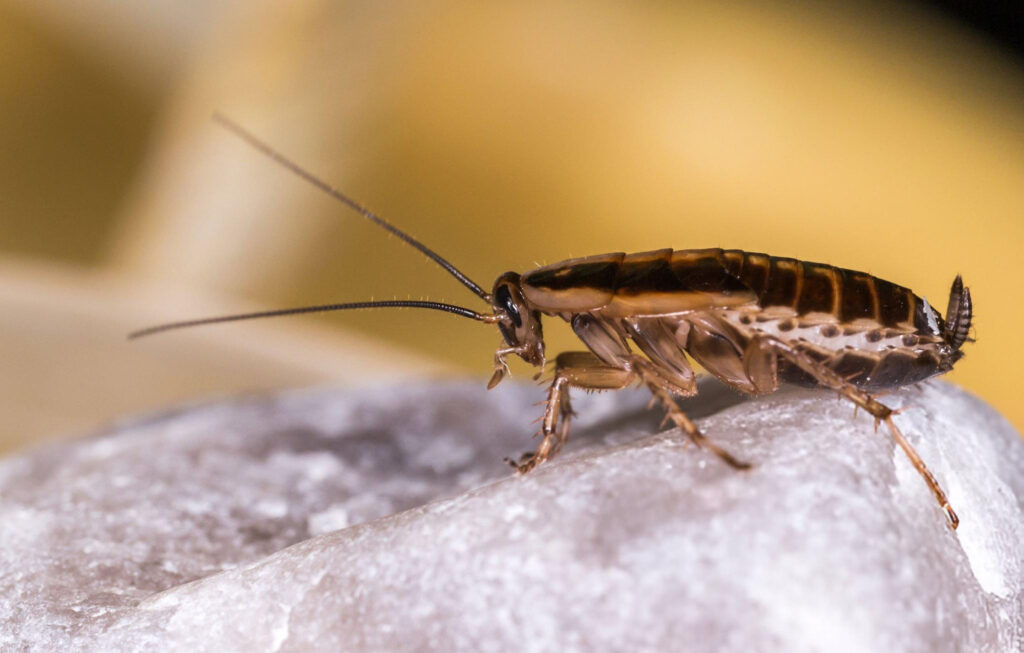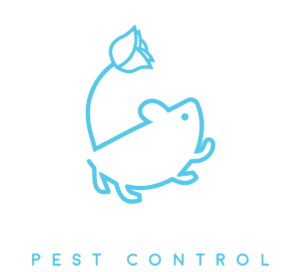German Cockroach Control

German Roaches: Act Fast. They Do.
First and foremost, this is a very serious pest that you will not control on your own. Further, you don’t want just anyone helping you with this issue. If your team lacks the in-depth knowledge and experience with this species of roach, they can easily make the problem worse, causing you a big headache and costing you more money.
What Are German Roaches?
German cockroaches (Blattella germanica) are the ultimate survivors, small but terrifyingly tough. These nimble pests are light brown or tan with distinct dark stripes running down their backs. Often associated with kitchens and bathrooms, German roaches can turn a clean, cozy home into their personal breeding ground faster than you can say, “Where’s the bug spray?”
Roaches are nocturnal pests, meaning if you see one during the day, there’s a strong chance you’ve got a full-blown infestation hiding behind the scenes. These critters aren’t just gross—they’re pros at hiding and multiplying. With the ability to produce hundreds of offspring in their lifetime, a single roach is never just a single roach.

Signs of a German Roach Infestation
If you suspect your home has become a playground for German roaches, look out for these red flags:
- Live sightings: Roaches scuttling across your floors at night or even worse, during the day.
- Egg capsules (oothecae): Small, brownish casings left behind in hidden areas like corners or under sinks.
- Droppings: Small black / brown specks resembling coffee grounds or black pepper around cracks, crevices, or your food storage.
- Musty odor: A distinct, unpleasant smell that becomes stronger with larger infestations.
- Shed skins: Roaches molt several times as they grow, leaving behind tell-tale exoskeletons.
If you’re experiencing any of the above signs, it’s time to take action, pronto!
The Dangers German Roaches Bring to Your Home
German cockroaches aren’t just creepy; they’re downright dangerous. These tiny invaders can:
- Trigger asthma and allergies: Their droppings, skin, and even saliva are potent allergens, especially for children.
- Spread harmful bacteria: Roaches travel through sewers and other unsanitary areas, picking up bacteria like E. coli and Salmonella. They then spread these pathogens over kitchen counters, food, and utensils.
- Contaminate food: German roaches love to invade pantries, where they spoil food by walking across it, defecating, and shedding skin. Yum!
Biology & Life Cycle
The life cycle of the German cockroach is characterized by three stages: egg, nymph, and adult. Under favorable conditions,
their reproduction can occur rapidly, contributing to infestations.
their reproduction can occur rapidly, contributing to infestations.
1. Egg Stage:
-
- Female German cockroaches produce egg capsules called oothecae. Each ootheca contains 30–40 eggs.
- The female carries the ootheca protruding from her abdomen until just before hatching, unlike other species that drop the egg capsule earlier. This behavior ensures a higher survival rate for the young.
- The incubation period for eggs is typically 28 days, after which nymphs emerge.
2. Nymph Stage:
-
-
- Upon hatching, nymphs are small, wingless, and darker in color. They pass through 5-7 molts (shedding of the exoskeleton) as they grow.
- During each molt, the nymphs get larger and start to resemble adult roaches more closely. This stage lasts 6 to 12 weeks, depending on environmental conditions.
- Nymphs are very active and begin feeding immediately after hatching, often forming large colonies in hidden areas.
-
3. Adult Stage:
- After their final molt, nymphs reach adulthood and develop wings, although, as mentioned, they rarely use them.
- Adult German cockroaches are capable of reproduction within a few weeks. Females can produce one ootheca every 20-25 days and may produce 4-8 oothecae over their lifespan.
- Adults live for around 100-200 days, and in ideal conditions, populations can explode quickly.
Reproductive Potential and Infestation Risk
The German cockroach’s rapid reproductive cycle makes it particularly difficult to control. A single female and her offspring can lead to thousands of roaches within a year. Because they mature quickly and produce many offspring, even a small infestation can escalate into a major one within weeks.
German cockroaches also exhibit strong aggregation behavior, meaning they tend to gather in large groups in hidden areas. This makes detection and control more challenging, as the vast majority of an infestation may remain out of sight.
How Do German Roaches Get Inside?
German roaches are excellent hitchhikers. They frequently enter homes hidden in grocery bags, cardboard boxes, used appliances, or even in furniture. Once inside, they find the nearest dark crevice, and the party begins. You might also unwittingly invite them in through second-hand electronics or packaging from infested areas.
Conditions That Attract German Roaches to Your Home
If your home has any of the following, you’re basically sending an engraved invitation to German cockroaches:
- Accessible food sources: Grease! Crumbs, unsealed food packages, dirty dishes, and pet food left out overnight are all-you-can-eat buffets for these pests.
- Moisture: Roaches need water to survive, so leaky faucets, damp areas, sinks holding water, and condensation provide an oasis for thirsty roaches.
- Clutter: Piles of magazines, newspapers, and cardboard boxes create the perfect hiding spots for roaches to thrive.
- Warmth: German roaches love a cozy environment, which is why they gravitate toward appliances that generate heat, like refrigerators and stoves.
10 Fascinating Facts About German Roaches
- Night owls: These insects are primarily nocturnal, so if you spot them during daylight hours, the infestation is likely already severe.
- Eating machines: They can digest just about anything, from soap to glue and even the binding of books.
- Terrifying longevity: German roaches can live for about 100 days, which is just long enough to create multiple generations of invaders.
- Squeeze through anything: German roaches can flatten their bodies and fit through cracks as thin as a dime.
- Roaches ‘talk’: They communicate through chemicals called pheromones, leaving trails to direct others to food or warn of danger.
Tips for Controlling German Roaches
If you’ve spotted a roach (or worse, several), it’s time to get tactical. Here’s what you can do:
- Sanitize your home—Keep counters clean, sweep floors, and don’t leave dirty dishes sitting overnight.
- Deep clean (and keep clean) the kitchen. German Cockroaches love grease. Beyond that, they’ll eat just about eat anything. Be sure to get the less commonly treated areas, like the sides of the stove, the hood vent, ceiling and other areas grease is likely to splatter and accumulate. Same with crumbs.
- Seal food—Store all pantry items in airtight containers, and don’t forget about pet food!
- Eliminate water sources—Fix leaky pipes and faucets, and keep your home dry.
- Declutter—Remove piles of paper, magazines, and cardboard that create roach-friendly hiding spots.
- Boxes & Bags—German Roaches often infest the factories where paper bags and cardboard boxes are made because they feed on the glue that holds them together. Swiftly discard such items to the exterior trash when deliveries are made
- Use bait stations—Strategically place cockroach bait around your home, particularly in dark, warm places where they congregate.
- Don’t spray repellents! – This often makes your countertops unsafe and can drive them to new areas in your home.
- Note the areas you see them and where they retreat—This will be useful information to the inspecting professionals.
Be Highly Selective in Choosing Professionals to Handle German Roaches
German roaches are experts at hiding, reproducing, and adapting to DIY methods. While over-the-counter sprays and traps might catch a few, it’s unlikely to wipe out the entire colony. Missing just one egg capsule can lead to hundreds of roaches infesting your home in no time. Plus, many roaches have developed resistance to common insecticides.
What’s more, it’s very common for technicians to be under-trained or ineffectively trained on this pest. A highly experienced and well-trained pest control team like Pasadena Pest Control’s knows where roaches hide, how they behave, and the comprehensive approach necessary to eliminate them—completely. We don’t just treat the problem; we prevent future infestations.
Effective German Cockroach Control requires extensive preparation and exhaustive treatment methods. We will teach you how to prepare and prevent and provide you the treatment of a lifetime to take care of this roach for good.
Safety First
“Is it Safe?”
At Pasadena Pest Control, we keep the safety of your family and pets at the forefront of our minds as we plan and work, doing so with minimal disruption to your daily life. We apply chemicals according to the label, which in California is among the strictest and safest in the nation. We take into account your pets and plants, your family and the features specific to your property. At Pasadena Pest Control, we are well-trained on safety procedures, eco-consciousness and educating our customers. And yes, we are licensed, bonded and insured.
When you work with us, you will always know what to expect, how to be prepared, when we are coming, when we’ve started and when we’re done. In short, we provide The Service We’d Want in Your Shoes.
Ready to Evict Those Roach Roommates?
Your German roach problem won’t go away on its own. Call Pasadena Pest Control now. You’ll get The Service We’d Want in Your Shoes.
Pasadena Pest Control: Your Roach-Free Future Awaits!
Questions Others are asking
We ❤️ love helping new customers! Don’t see your question answered below? Call us and we’ll
be happy to provide more information.
be happy to provide more information.
German cockroaches are light brown to tan with two dark parallel stripes behind their heads and measure about 1/2 to 5/8 inches in length.
Commonly found in kitchens and bathrooms, they seek warmth and food sources.
They can transmit bacteria like Salmonella and E. coli, leading to food poisoning and dysentery.
